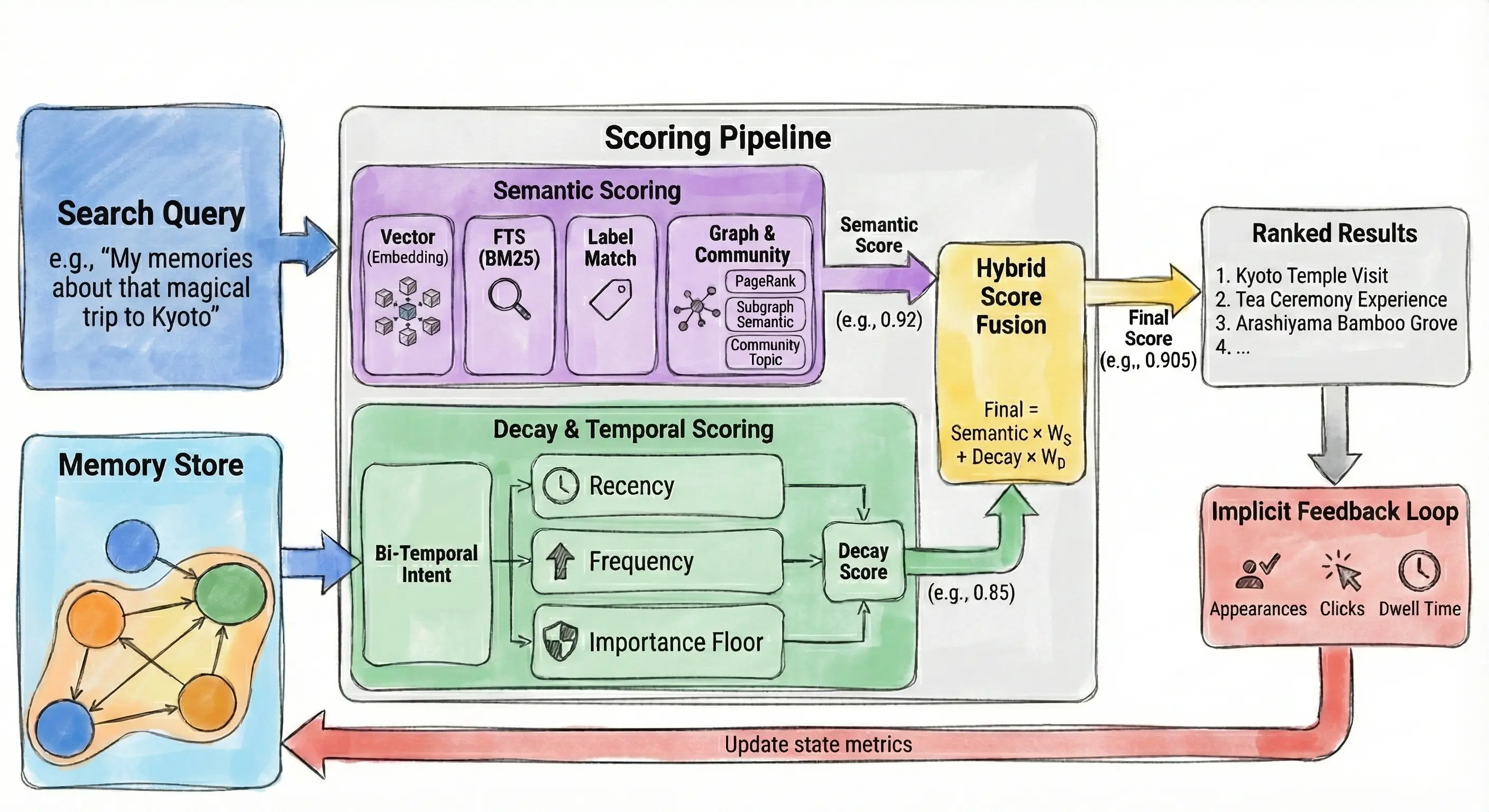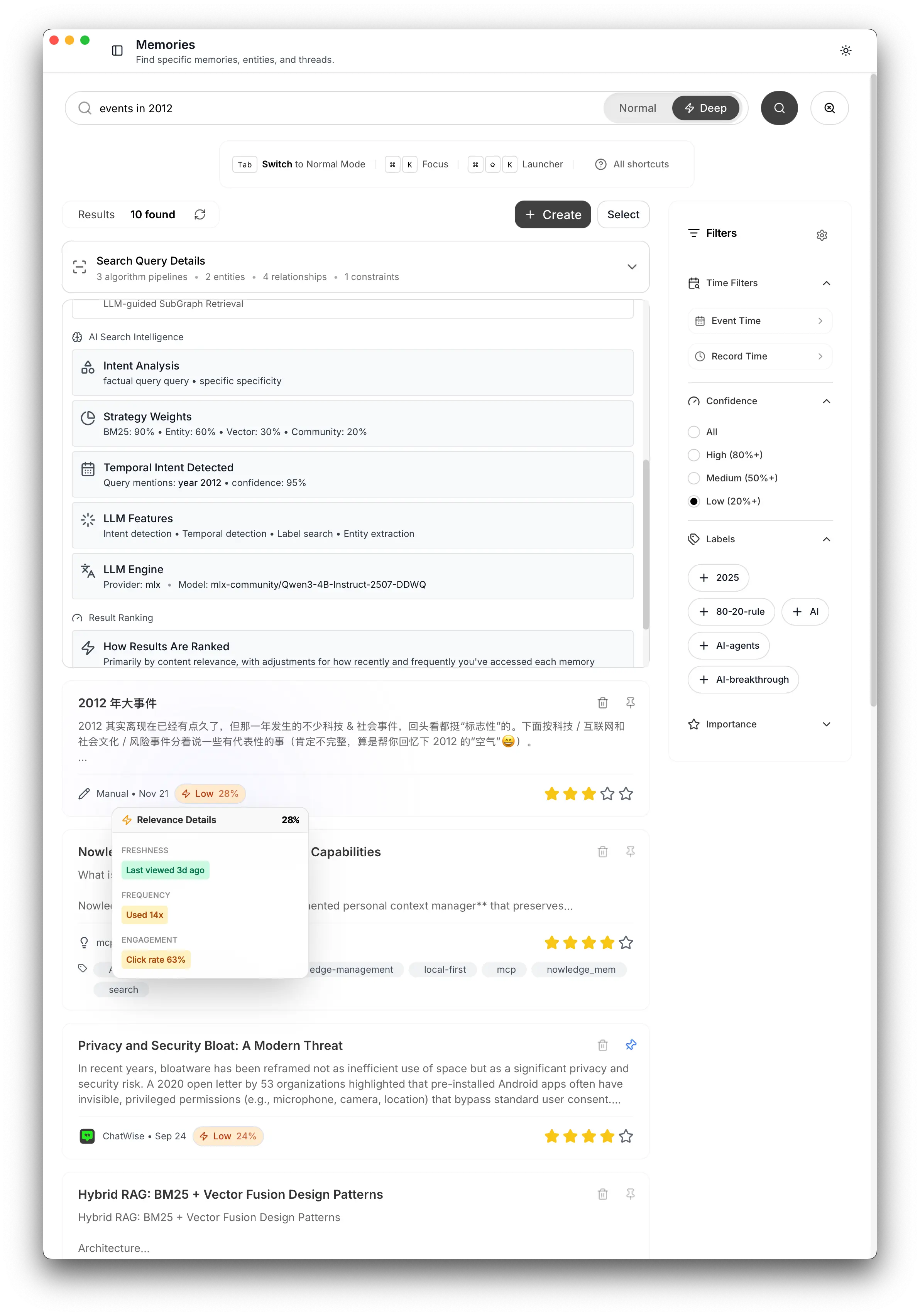Search & Relevance
How Nowledge Mem finds and ranks your memories
This page explains how search works in Nowledge Mem: how we find matching memories, rank them by relevance, and learn from your usage patterns.
The Scoring Pipeline
When you search, Nowledge Mem doesn't just match keywords. It combines multiple signals to surface the most useful results.

Semantic Scoring
This track finds memories that match what you're looking for:
- Meaning-based search: Finds memories by semantic similarity, not just exact words. Search for "design patterns" and find memories about "architectural approaches."
- Keyword search: Catches exact phrases and technical terms using BM25 ranking.
- Label matching: Surfaces memories with matching tags.
- Graph traversal: Discovers connected memories through entities and topic communities.
Decay & Temporal Scoring
This track adjusts results based on freshness and your usage:
- Recency: Recently accessed memories score higher. We use exponential decay with about a 30-day half-life.
- Frequency: Memories you access repeatedly become more durable (logarithmic scaling with diminishing returns).
- Importance floor: High-importance memories maintain minimum accessibility even when unused.
- Temporal matching: Boosts memories whose event time matches your query (deep mode only).
These tracks combine into a final score that determines result ranking.
Memory Decay
Memories naturally fade over time, unless you reinforce them by using them.
How It Works
Recency: A memory accessed yesterday scores much higher than one from three months ago. The 30-day half-life means scores roughly halve each month without access.
Frequency: Your 10th access to a memory matters more than your 100th. This mirrors how human memory works: early repetitions build durability, later ones have diminishing returns.
Importance Floor: Memories marked as high importance never fully decay. Even untouched, they maintain minimum accessibility. This protects foundational knowledge from fading away.
What This Means
- Active knowledge stays fresh
- Old memories don't disappear, they just rank lower when equally relevant
- Important knowledge persists regardless of access patterns
- The system learns from your behavior automatically
Temporal Understanding
Nowledge Mem understands two kinds of time.
Event Time vs Record Time
Event time is when something actually happened:
- "The 2020 product launch"
- "Last quarter's decisions"
- "Before we migrated"
Record time is when you saved the memory. You might record a memory today about an event from 2020.
This matters for queries like "recent memories about 2020 events": things you saved recently (record time) about events from 2020 (event time).
Temporal Intent Detection
Deep Mode Feature
Temporal intent detection requires deep mode search. In fast mode, temporal references are matched by keywords only.
In deep mode, the system interprets temporal references:
| Query | Understanding |
|---|---|
| "Decisions from 2023" | Event time: 2023 |
| "Recent memories" | Record time: recent |
| "Recent memories about 2020" | Event: 2020, Record: recent |
| "Before the migration" | Event: before that event |
Fuzzy references like "last quarter," "around 2020," or "early this year" are translated into meaningful filters.
Date Precision
When you save a memory about "early 2020," the system:
- Normalizes to a searchable date (2020-01-01)
- Tracks precision level (year, month, or day)
- Preserves original meaning for accurate matching
This lets "memories from 2020" (year precision) work differently from "memories from January 2020" (month precision).
Feedback Loop
Your usage patterns continuously improve search relevance.
What We Track
| Signal | What It Captures |
|---|---|
| Appearances | How often a memory shows in results |
| Clicks | When you open a memory to view details |
| Dwell time | How long you spend reading |
How It Improves Search
- High click-through rate indicates the memory is genuinely useful
- Long dwell time suggests valuable content
- Frequent appearances without clicks may indicate declining relevance
You don't need to do anything special. Just use Nowledge Mem normally.
Graph-Powered Discovery
The knowledge graph enables discovery through connections.
How Memories Connect
Each memory can link to:
- Entities: People, concepts, technologies, places mentioned
- Other memories: Through shared entities or relationships
- Communities: Graph Analysis detected topic clusters
Search Through Connections
Entity-mediated: Find memories about "database optimization" even when tagged differently, through shared entities like PostgreSQL or indexing.
Community-mediated: A search about "authentication" might surface memories from your "Security Practices" community.
Graph expansion: Start from one memory and explore connected knowledge.
Search Modes
Two modes available across all interfaces:
Fast Mode
- Under 100ms typical response
- Direct semantic and keyword matching
- Entity and community search without language model analysis
- Best for quick lookups
Deep Mode
- Full language model analysis
- Temporal intent detection (e.g., "recently working on; social events in last decade")
- Query expansion for better recall
- Context-aware strategy weighting
- Better for exploratory searches
Both modes work in main search, global launcher, and API.
Result Transparency
Nowledge Mem shows you exactly why each result ranked where it did.
Search Query Details
After each search, you can view detailed analysis of how your query was interpreted:
- Which search strategies were used
- Temporal intent detection results (in deep mode)
- Query expansion and entity extraction
Score Breakdown
Hover over any result's score to see a breakdown of how it was calculated:
- Semantic score: How well the content matches your query
- Decay score: Freshness based on recency and frequency
- Temporal boost: Event time relevance (when applicable)
- Graph signals: Entity and community connections

This transparency helps you understand how your usage patterns influence results and why certain memories surface for specific queries.